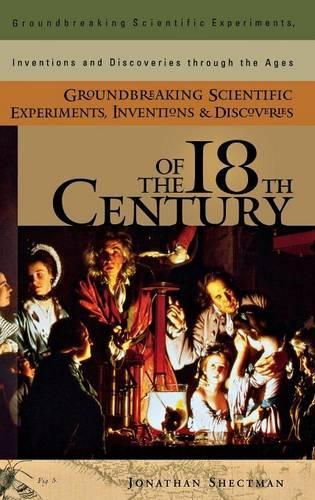
Groundbreaking Scientific Experiments, Inventions, and Discoveries of the 18th Century
(Hardback)
Publishing Details
Groundbreaking Scientific Experiments, Inventions, and Discoveries of the 18th Century
By (Author) Jonathan Shectman
Bloomsbury Publishing PLC
Greenwood Press
30th September 2003
United States
Classifications
General
Non Fiction
509.033
Physical Properties
Hardback
368
Width 156mm, Height 235mm
737g
Description
The 18th century saw the emergence of the industrial and chemical revolutions and witnessed the near-universal acceptance of applied science. It was a time of revolutionary, lasting transformation for the practice of science and mathematics. Most procedures and precepts of modern science took hold during the 18th century, when scientists first paired scientific research with practical application to astonishing results. In over 60 alphabetical entries, Shectman examines at the tremendous scientific discoveries, inventions, and inquiries of the period. Familiar topics such as the steam engine and hot air balloon are covered, along with lesser-known topics such as the Watt copy press and Newton's experimentum crucis. A thorough discussion of each entry's scientific impact provides readers with an understanding of the lasting social and political importance of these advancements. Narratives enrich the entries by adding context and perspective to the century's fascinating scientific history. Students and researchers will find this reference book easy to use. Included are an appendix of entries listed by scientific field, a glossary of terms, indexes by name and subject.
Reviews
[t]his well-organized work offers sixty-two essays on an impressively detailed range of significant practical applications of science, new discoveries, and investigations carried out between 1687and 1799. Readers will find the introduction very valuable for its thoughtful consideration of the place of science in the eighteenth century and that century's role as the bridge between the mindsets of figures as disparate as Isaac Newton and James Watt....The "Timeline of Important Events" offers more than merely a simple chronology, with numerous detailed annotations permitting an overview of the progress of eighteenth-century science by decade. This volume and the accompanying members of the series fit well within the scope of any general science collection in libraries of all types from high school through college and university.-E-STREAMS
[A]imed at middle school and high school students, undergraduates who are not science majors, and the general public--an audience that would probably find the ignored social and cultural aspects valuable and interesting.-Library Journal
[R]ecommended....advanced high-school students, college-level nonscience majors, and adult readers.-Booklist/Reference Books in Brief
Human curiosity in the 18th century expanded knowledge in profound ways. Digestion was discovered to be a chemical process. Light was first produced by electricity. Combinations of the three primary colors were determined sufficient to produce all other colors. The metric system was introduced. The idea that humans function as complex machines first appeared. Carbon dioxide was discovered. Air was found to be a collection of gases. Insects were discovered as pollinators. Black holes were first proposed. Water was determined to be compound in nature. Heat was found to be a form of energy. Shectman explores these and many more important 18th-century discoveries and innovations in this well-organized and pleasantly readable encyclopedic resource....Highly recommended. General readers; lower-division undergraduates.-Choice
"this well-organized work offers sixty-two essays on an impressively detailed range of significant practical applications of science, new discoveries, and investigations carried out between 1687and 1799. Readers will find the introduction very valuable for its thoughtful consideration of the place of science in the eighteenth century and that century's role as the bridge between the mindsets of figures as disparate as Isaac Newton and James Watt....The "Timeline of Important Events" offers more than merely a simple chronology, with numerous detailed annotations permitting an overview of the progress of eighteenth-century science by decade. This volume and the accompanying members of the series fit well within the scope of any general science collection in libraries of all types from high school through college and university."-E-STREAMS
"Aimed at middle school and high school students, undergraduates who are not science majors, and the general public--an audience that would probably find the ignored social and cultural aspects valuable and interesting."-Library Journal
"Recommended....advanced high-school students, college-level nonscience majors, and adult readers."-Booklist/Reference Books in Brief
"[A]imed at middle school and high school students, undergraduates who are not science majors, and the general public--an audience that would probably find the ignored social and cultural aspects valuable and interesting."-Library Journal
"[R]ecommended....advanced high-school students, college-level nonscience majors, and adult readers."-Booklist/Reference Books in Brief
"Human curiosity in the 18th century expanded knowledge in profound ways. Digestion was discovered to be a chemical process. Light was first produced by electricity. Combinations of the three primary colors were determined sufficient to produce all other colors. The metric system was introduced. The idea that humans function as complex machines first appeared. Carbon dioxide was discovered. Air was found to be a collection of gases. Insects were discovered as pollinators. Black holes were first proposed. Water was determined to be compound in nature. Heat was found to be a form of energy. Shectman explores these and many more important 18th-century discoveries and innovations in this well-organized and pleasantly readable encyclopedic resource....Highly recommended. General readers; lower-division undergraduates."-Choice
"[t]his well-organized work offers sixty-two essays on an impressively detailed range of significant practical applications of science, new discoveries, and investigations carried out between 1687and 1799. Readers will find the introduction very valuable for its thoughtful consideration of the place of science in the eighteenth century and that century's role as the bridge between the mindsets of figures as disparate as Isaac Newton and James Watt....The "Timeline of Important Events" offers more than merely a simple chronology, with numerous detailed annotations permitting an overview of the progress of eighteenth-century science by decade. This volume and the accompanying members of the series fit well within the scope of any general science collection in libraries of all types from high school through college and university."-E-STREAMS
Author Bio
JONATHAN SHECTMAN is former editor of a series of science education books written by the National Science Resources Center, an arm of the Smithsonian Institution.
